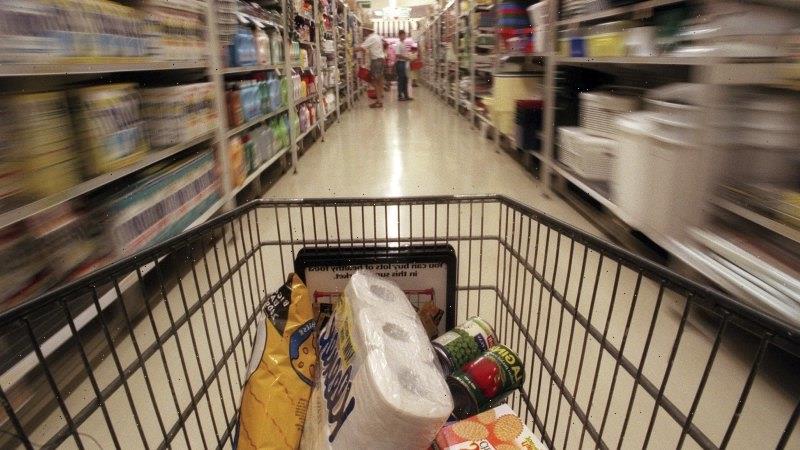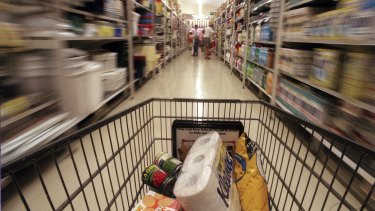The biggest increase in consumer prices since 2000 is expected to force the Reserve Bank into an interest rate rise just days out from the May 21 federal election, bringing the debate over cost-of-living back to the centre of the campaign in its final critical days.
Data from the Australian Bureau of Statistics on Wednesday showed inflation rising by 5.1 per cent over the past year – more than twice the rate of wages growth – after a 2.1 per cent spike through the first three months of the year.
Price pressures are higher on essential goods, inlcuding beef, vegetables and toilet paper.Credit:Nick Moir
The result, which was much higher than markets, the Reserve Bank or the recent federal budget had expected, was the worst inflation result since the introduction of the GST.
Financial markets now believe the RBA will take the official cash rate, currently at a record low of 0.1 per cent, to 0.25 per cent at next Tuesday’s meeting. The same markets believe home buyers will be hit by consecutive rate rises through the rest of the year with the cash rate tipped to be at 2.5 per cent by year’s end.
Prime Minister Scott Morrison said Australians should trust the Coalition to lead the country through the economic challenges ahead.
“As Australia comes out of these difficult times, we don’t want them to be hit down again by what are causes well beyond Australia’s borders,” he said on Wednesday afternoon.
“But what we’ve shown as a government is we’ve been able to keep as much pressure down on those forces as good governments can.”
But Shadow Treasurer Jim Chalmers said cost of living pressures had been lifting since well before global events, including the war in Ukraine, put pressure on inflation.
“This inflation number should be a wake-up call for a government which is out of touch, out of plans, and out of time,” he said.
EY chief economist Cherelle Murphy said there was enough evidence for RBA to easily justify a rate hike of 0.25 per cent or more next week.
“A record low cash rate of 0.1 per cent is clearly now no longer appropriate for this economy, meaning the Reserve Bank must join other central banks around the world and tighten monetary policy. To not do so risks the RBA losing credibility,” she said.
Underlying inflation, which takes out the most extreme price movements and which is closely watched by the Reserve Bank, rose to 3.7 per cent, its highest level since early 2009.
The price pressures are most acute on essential goods and services, with their costs up by 6.6 per cent over the past year. They include petrol, up by 35.1 per cent, beef (12.1 per cent), vegetables (12.7 per cent), non-durable household goods like toilet paper (6.7 per cent) and coffee (8.2 per cent).
Among discretionary items, inflation is running at a much more moderate 2.7 per cent. This included the costs of international travel that plummeted more than 20 per cent in the March quarter alone.
Worryingly for the Reserve Bank, more than half of all categories tracked by the bureau showed quarterly price increases of more than 3 per cent. In the December quarter, it was 35 per cent.
AMP chief economist Shane Oliver said while there are some temporary factors that have lifted quarterly inflation, the effects of global supply issues and higher commodity prices could linger for the rest of the year.
“[It] means that we haven’t reached the peak in annual inflation yet,” he said.
Just a year ago the Reserve Bank was expecting interest rates to remain on hold until 2024 because of subdued inflation.
But financial markets now believe the bank will have to use its May 3 meeting to deliver the first increase in the official cash rate since November 2010. The last time the bank, which sets interest rates independently of the federal government, moved rates in an election campaign was just weeks out from the 2007 poll.
KPMG chief economist Dr Brendan Rynne said while inflation has lifted to a “brisk walk” in Australia, it was not yet running at the levels experienced in countries including the US and the UK.
“KPMG remains of the view the central bank will hold off raising rates until after the election, but given the sustained and broad-based increases in prices the first cash rate movement upwards could well be 0.4 per cent,” he said.
The Commonwealth Bank also believes the RBA will wait until June to lift rates, taking at face value the RBA’s April meeting minutes that said the board agreed to wait for wage growth data.
Michael Blythe, economist at analytics firm PinPoint Macro, said the key reason Governor Phil Lowe had fought against lifting interest rates so far was to reach the goal of full employment, and the board was unlikely to abandon that goal now.
“No doubt the RBA boffins are busily tearing the numbers apart at present. The available fig leaves to hide behind are getting smaller,” he said.
Barrenjoey economists Jo Masters and Johno McMenamin said the risk of waiting until June was that inflation expectations become entrenched.
Cut through the noise of the federal election campaign with news, views and expert analysis from Jacqueline Maley. Sign up to our Australia Votes 2022 newsletter here.
Most Viewed in Politics
From our partners
Source: Read Full Article

